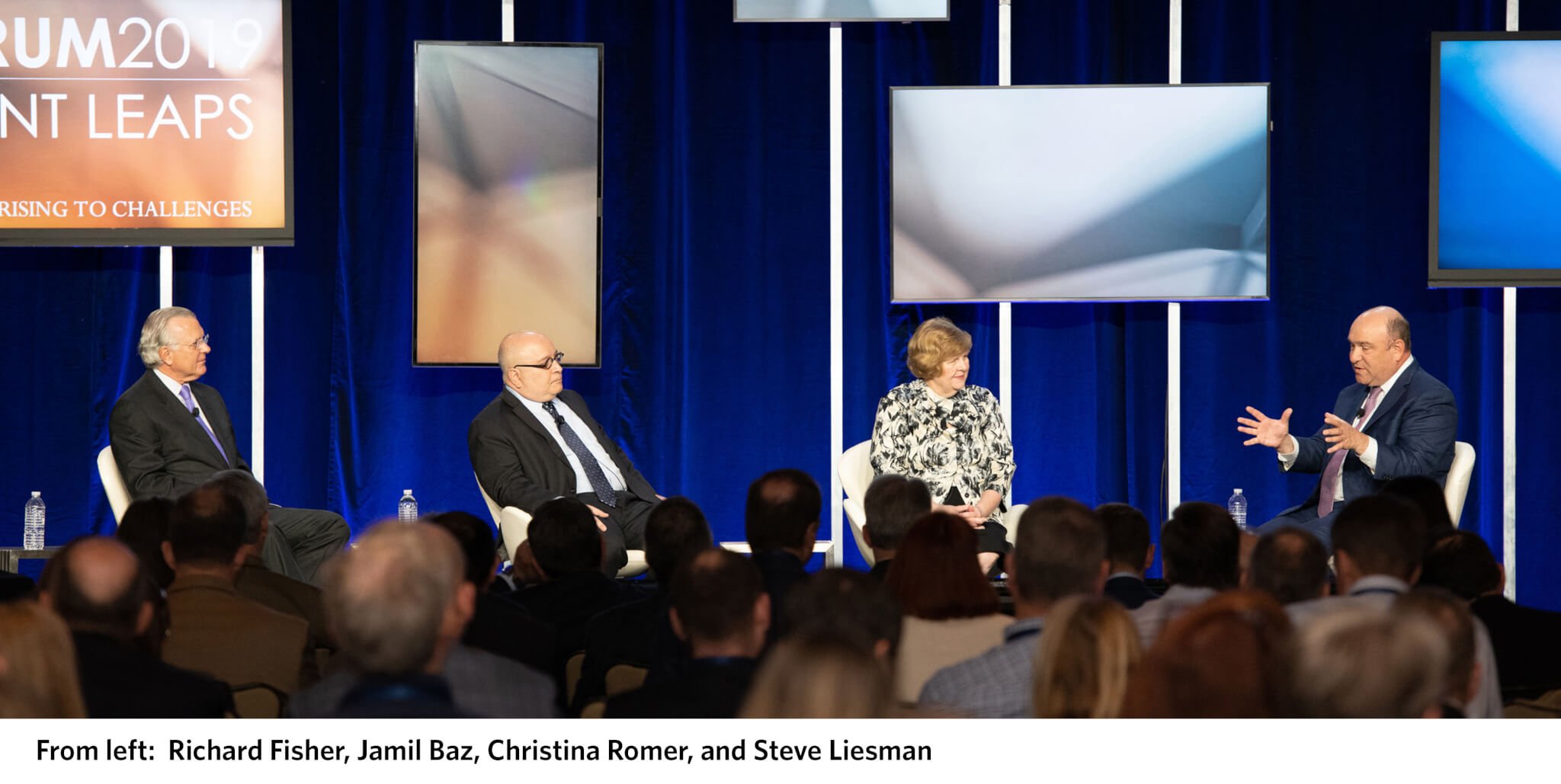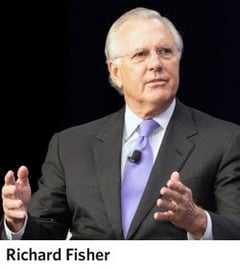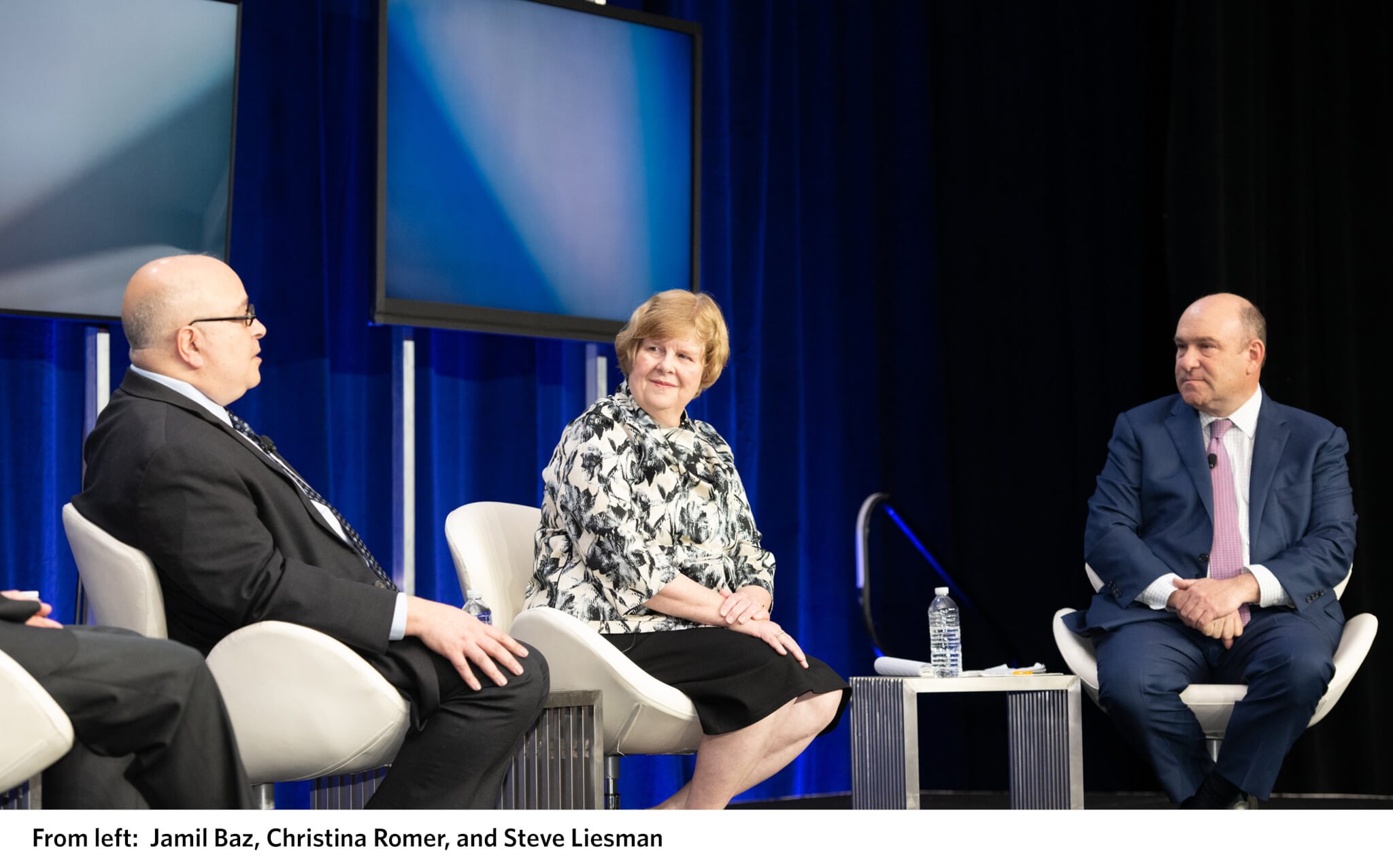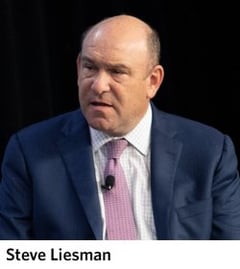How to think about tariffs, deficits, valuations, leverage, growth and other issues
What signals should institutions be mindful of as they make portfolio decisions in the current environment? A panel of experts took on this question at Commonfund Forum 2019.
The panel was moderated by Steve Liesman, Senior Economics Reporter for CNBC. The panelists were: Jamil Baz, Head of Client Solutions and Analytics, PIMCO; Richard Fisher, former President and CEO of the Federal Reserve Bank of Dallas; and Christina Romer, Professor of Economics at UC Berkeley and Co-Director of the Program in Monetary Economics of the National Bureau of Economic Research. The following are excerpts from the discussion.

Steve Liesman: In 2017 the world experienced unexpected growth. In 2018 global growth slowed but added perhaps 50 basis points to U.S. GDP. Respondents to our recent CNBC Fed survey said they saw 40 basis points coming off domestic GDP in 2019. So, what’s happening in our world today?
Christina Romer: All the big forecasters—IMF, OECD—say growth is slowing. A lot of it is outside the U.S. We know China is certainly slowing down. There’s a lot of talk about Europe. That’s where I am most concerned … who knows what will happen with Brexit, Italy and other issues? And while the U.S. economy is slowing, things are pretty stable. We’re chugging along.

—Richard Fisher

Liesman: Richard, Italy had two quarters of negative GDP, the German auto industry is ailing, there’s Brexit. How serious is Europe?
Richard Fisher: Negative interest rates have distorted the system dramatically and have given a pass to many. The fact that Italian sovereigns trade through U.S. treasuries amazes me. Same with the German 10-year hovering around zero and the French O.A.T. (government bonds) at the same level. As Warren Buffett says, when the tide goes out you find out who’s swimming naked. When this tide of liquidity goes out, which it will at some point, you’re going to see some very ugly credits flopping around in the sand. If I come to you and say, “I’m going to lend you money and I’m going to pay you to take it” you’re going to take risk, which is abnormal and distorts the capital structure.
Liesman: Can the U.S. remain an island in the storm here?
Fisher: We have Mexico to our south and Canada to our north. So, we’re blessed in the sense that we’re less trade-dependent than most economies. Nevertheless, it does impact us because the world is financially and electronically integrated. It affects our currency and it affects our bond market. We’re not immune, but the linkages are more powerful financially than they are from a purely trade standpoint.
Romer: I second that idea. Relative to the rest of the world, the direct impact is small just because we are such a big, diverse economy. But these indirect effects will impact what American firms do, what our stock market does and how our consumers feel.

—Jamil Baz
Liesman: A huge chunk of S&P earnings come from abroad. It’s possible the U.S. skirts a global downturn, but not necessarily from an earnings standpoint?
 Jamil Baz: I think it boils down to a couple of things. First, let’s look at the secular trend. Earnings-to-GDP as a ratio is living in the tails. There’s no question about that. And what is this linked to? It’s linked to inequalities, to wealth-to-GDP as a ratio. We know that when wealth-to-GDP reaches 700 percent, which is where it is in the U.S. today, it tends to revert to the mean. That’s one story.
Jamil Baz: I think it boils down to a couple of things. First, let’s look at the secular trend. Earnings-to-GDP as a ratio is living in the tails. There’s no question about that. And what is this linked to? It’s linked to inequalities, to wealth-to-GDP as a ratio. We know that when wealth-to-GDP reaches 700 percent, which is where it is in the U.S. today, it tends to revert to the mean. That’s one story.
The other story is that earnings are linked to leverage. There is a semi-obscure relationship called the Kalecki profit equation, named after a 1940s professor at Cambridge who discovered something very simple: Earnings are equal to the sum of two things—investment and the change in leverage. The bad news is that leverage today is at its absolute highest. If you believe, as I do, that leverage is not sustainable, you’ve got to also believe that earnings are not sustainable either.
Liesman: Richard, you were at the Fed through the financial crisis and for a good portion of it afterwards. What’s your view of the Fed’s ability to identify and deal with a problem like leverage?
Fisher: The Fed ha
s a superb ability to use macroeconomic tools along with databases and anecdotal evidence. The governors know we’re a hyper-leveraged economy. On the fiscal side, we are leveraging “G” (government) to the hilt right now. We’ll have another $1.3 trillion in leverage at the end of this year.
We had long discussions about the potential result of our policy, particularly after the crisis. It was obvious that corporations were going to restructure their balance sheets. At the time, they weren't growing their top line, but they wanted to look as good as they could on the bottom line. So, they took advantage of the low interest rates and bought back shares and leveraged their earnings. The question now is, how do we get out of the hyper-leverage trap because we still have unprecedentedly low interest rates.
Liesman: It’s amazing how unhip Richard is because he knows that the cool thing now is that deficits don't matter. We walk around with a swagger. Deficits don't matter. Right?
Fisher: It’s modern monetary theory.
Liesman: Deficits don't matter.
 Romer: Wrong! I was in Washington in 2009 and 2010. Everybody was so worried about the deficit. We were in the middle of the worst recession in two or three generations and the deficit discussion was everywhere. Now we’re at full employment. So, everyone thinks, who cares about the deficit? We need to be careful about leverage in the public sector versus leverage in the private sector.
Romer: Wrong! I was in Washington in 2009 and 2010. Everybody was so worried about the deficit. We were in the middle of the worst recession in two or three generations and the deficit discussion was everywhere. Now we’re at full employment. So, everyone thinks, who cares about the deficit? We need to be careful about leverage in the public sector versus leverage in the private sector.
There’s a healthy side to this in that you don't need to obsess about your debt and deficit in a crisis. But that’s not the case now. When the economy is growing and the sun is shining like it is now, that’s the time to fix the holes in your roof. The sun may be shining but we are still making big holes in our roof. That is not a sensible policy.
Liesman: I describe the Fed’s current objective as preparing for the next recession without creating it. Is the Fed prepared for the next recession if it needs to cut rates and increase the size of the balance sheet again?
Romer: The so-called Powell Pivot—a focus on sustaining economic expansion rather than inflation control—should have been what they were doing all the time. The Fed always said it is data-dependent. Well, the data were not as strong as they thought, so it made complete sense to put the brakes on rate increases.
Is the Fed prepared for the next one? Realistically, interest rates are going to be low for a long time. The Fed is not going to have the ability to do conventional monetary policy by cutting interest rates. One place where they’re not as prepared as I wish they were is in thinking about the tools available when you don't have your main tool, which is cutting the federal funds rate. That’s a place where central banks throughout the world are not thinking hard enough and communicating better. So, we’re in a pretty good place. But, if you were to ask what keeps me up at night, it’s not having the tools that we had back in 2008.
Liesman: Jamil, the question I have for you, given the existing structure and the obvious implications about what happens in the next downturn, is how do you position yourself for that?
Baz: It’s difficult. The biggest issue today is a double conundrum. In the U.S., equity is expensive to bonds, meaning that real equity yields are too low against real bond yields, and yet bonds are expensive to the underlying economics. In other words, real bond yields are too low against GDP growth. So, what does this mean? It means by the transitive property; if equity is expensive to bonds, which in turn are expensive to economics, then equity is super-expensive to the underlying economics. Equity is reaching extraordinary levels, and no matter what you look at all the value metrics are living at the tails.
What do you do? Back to valuation, some things are much cheaper than others, for example, some emerging market equity. Some southern European equity is trading extremely cheap against the U.S. If you look at exchange rates, once again emerging market exchange rates are extremely cheap. South Africa, Brazil, Mexico, Turkey—these are very cheap currencies. Agricultural commodities are incredibly cheap even though assets overall are very expensive.
Lastly, if you look at interest rates, clearly bond markets in the U.S. are cheap against Japan, for example, or against Europe. Japan has 600 percent total debt to GDP and 240 percent public debt to GDP. And yet the JGB contract is trading at negative yields.

—Christina Romer

Liesman: Wait … I’ve watched this enough times. When a big negative happens, even if it’s a big negative for the U.S., nobody goes scurrying into the South African rand, right? I would be hard-pressed to say the world’s going to blow up and I need to be in the Thai baht. Everybody floods to the U.S.
Baz: That’s a great point. But portfolio construction is all about making sure that you have all the relative value trades that make sense, but then calibrate them to the beta. In other words, you want to make sure that you have relative value relationships that make sense, but at the same time be cognizant that there are some trades out there that are cyclical, so make sure that you have anti cyclical trades as well. In other words, combine the beta and the alpha in the portfolio.
Romer: We’ve talked a lot about risks here. One thing that is not getting enough play is the slowdown in normal growth. Before the financial crisis, we thought a normal number for GDP growth was 2 ½ percent. Go back a few decades and it was 3 percent. Now all the forecasters are saying about 1.8 percent if we’re lucky. What that change means for the economy, standards of living and stock market fundamentals is huge. The thing that’s worrying me is long-run growth because that’s what determines how well or how poorly we can handle all the debt that we have.

Liesman: An underlying premise of the tax cuts is that it would get into the DNA of the economy and change the trajectory of potential growth. In the first year, it seemed to work. Now the President’s Council of Economic Advisors has 3 percent built in through 2021. Is that a realistic forecast?
Romer: No one thinks it’s terribly realistic. Everybody knew that a tax cut would cause a temporary burst by increasing aggregate demand. That’s why you cut taxes in the middle of a recession. But the idea that cuts would get into the DNA and change potential growth—that is a topic economists have studied with every little tweak of the tax system. They try to look at the long-run incentive effects. And it’s not that they’re not there. They’re statistically significant, but small. This idea that a tax cut, even a big tax cut, would somehow spark GDP growth by a percent or two was never realistic. We’re seeing this play out.
Baz: We cut taxes and increased the budget deficit at precisely the point when we didn’t need to. The budget deficit is at 5 percent of GDP. At a similar point in the cycle under the Clinton administration, we had a 2 percent surplus to GDP. This is what I would call an act of financial vandalism.
Liesman: Would you finger the tariff and the trade tensions as being responsible for what’s happening globally?
Fisher: It has a big impact in terms of supply lines and linkages. It has a bigger impact in Europe than it does in the U.S. And it has a huge impact in China. Ultimately, it’s a case of liberating businesses from a regulatory standpoint and then putting constraints back on them in terms of their supply chains. I understand the negotiating position the U.S. is taking, particularly vis-à-vis China, but we’ll just have to see how long this takes to get a result. By the way, I think what the Chinese will do is what they always do. They’ll give us a big gift, and the president can beat his chest and say it’s the biggest trade deal in history. Of course it’s the biggest trade deal in history—because the economies are so large. The bigger issue ahead is an administration pivot towards Europe and going after the Europeans to take away their trade preferences.
Romer: I agree that the direct effects of the tariffs are pretty small … not just for us, but for most of the world. But this confidence or uncertainty effect is a different matter. How can you set up your new supply chain when you have no idea if that country’s going to be in or out of your preferential system?
Liesman: Jamil, who blinks first on this, China or the U.S.?
Baz: The U.S. for a very simple reason: Trump stands for re-election in less than two years. How about Xi in China? How about never?
Liesman: Richard, what’s the chance that there ends up being a rate cut sometime during the year?
Fisher: The Fed’s dilemma is balancing the short term and the long term. Right now, the Fed has a limited toolkit to offset any economic weakness. There’s a finite number of cuts before rates go back to zero and expanding the balance sheet once again would get a lot of pushback from Congress. The central bank of the U.S. is pretty good at thinking about the long term. These are earnest people, devoted to getting it right, whether you agree with them or not. Regarding the economy, I’ll offer an analogy: In the best of times, the U.S. is like the famed thoroughbred Secretariat at the 1973 Belmont Stakes … beating the field by 31 lengths. In the worst of times, we are the best-looking pony in the glue factory of the global economy. This is an important point: Don’t forget how dynamic and miraculous the U.S. economy is. It may be blind faith, but it has worked for well for about two and a half centuries.



